The Easiest Way To Get Rid Of Carpenter Ants
Carpenter ants get their name from the way they chew through wood, indoors and out. Unlike termites, they do not eat the wood; they simply chew through the wood and push it out of the tunnels they create, according to Iowa State University Extension and Outreach. Although carpenter ants can damage any wood item, they prefer damp wood. In nature, they serve the purpose of helping trees decompose, but around the house, they can cause a lot of damage. Their existence may also indicate a problem with rotten wood caused by insufficient drainage or a plumbing leak.
Signs of a carpenter ant infestation include seeing the large ants themselves, which are ¼ to ½ inch long and dark brown or black, per Maggie's Farm Products. They may or may not have wings. You may also notice an area of damaged wood combined with a product that looks like very fine sawdust. Ants burrow into wood to make a nest for their colony. To prevent further damage, it is vital to take action as soon as you see any signs of carpenter ants.
Eliminating existing infestations
To get rid of carpenter ants indoors, Terminix suggests starting by drilling holes at least 3 feet on each side of the affected area. The holes should go through the drywall so you can access the space between the interior and exterior walls. Place holes about every 6 inches, but be careful to avoid wires or plumbing. Once all your holes are drilled, gently send a puff of boric acid into each hole. Because you may need to repeat this treatment, do not seal up the holes until you are sure the infestation is gone. Boric acid is inexpensive and is available at most hardware stores. Although it is generally considered to have low toxicity, according to the National Pesticide Information Center, it is still a good idea to keep children and pets away.
For outdoor carpenter ants, you can use stronger insecticides, but be careful to keep pets and children away from the infested area. If the ants are in a wooden garden bed, a non-toxic pest control product is your best option. Boric acid can also be used outdoors but must be reapplied after rain.
Preventing future infestations
Once you get rid of your carpenter ants, it is important to fix what attracted the ants in the first place: damp wood. Maggie's Farm Products suggests ensuring your home has proper drainage and no leaky pipes. For very humid spaces, such as basements, you can run a dehumidifier to prevent the wood in your home from becoming damp. Replace all rotting wood on your interior and exterior walls.
Sometimes carpenter ants enter your home by traveling along the branches of trees and bushes. Keep all bushes and tree limbs pruned so that they do not touch your home. This is also true for firewood and any other wood items, such as outdoor furniture or brush piles. The fewer access points ants have to your home, the better!
If ants, fleas, ticks, and other outdoor pests are an ongoing problem, consider treating your yard with a broad spectrum insect killer made for lawns. These products come in granules and sprays. Pest control companies also often offer this service, and some specialize in lawn pest control.


